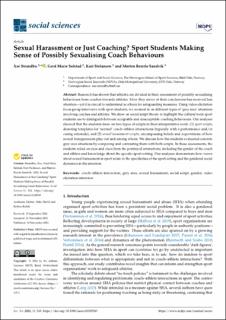| dc.contributor.author | Strandbu, Åse | |
| dc.contributor.author | Solstad, Gerd Marie | |
| dc.contributor.author | Stefansen, Kari | |
| dc.contributor.author | Sandvik, Morten Renslo | |
| dc.date.accessioned | 2023-03-02T12:01:16Z | |
| dc.date.available | 2023-03-02T12:01:16Z | |
| dc.date.created | 2022-12-06T12:07:46Z | |
| dc.date.issued | 2022 | |
| dc.identifier.citation | Social Sciences. 2022, 11(12), Artikkel 543. | en_US |
| dc.identifier.issn | 2076-0760 | |
| dc.identifier.uri | https://hdl.handle.net/11250/3055337 | |
| dc.description | This article is an open access article distributed under the terms and conditions of the Creative Commons Attribution (CC BY) license (https://creativecommons.org/licenses/by/4.0/). | en_US |
| dc.description.abstract | Research has shown that athletes are divided in their assessment of possibly sexualising behaviours from coaches towards athletes. How they arrive at their conclusions has received less attention—yet it is crucial to understand as a basis for safeguarding measures. Using video-elicitation focus group interviews with sport students, we zoomed in on different types of ‘grey area’ situations involving coaches and athletes. We drew on social script theory to highlight the cultural tools sport students use to distinguish between acceptable and unacceptable coaching behaviours. Our analyses showed that the students drew on two types of scripts in their interpretative work: (1) sport scripts, denoting templates for ‘normal’ coach–athlete interactions (typically with a performance and/or caring rationale), and (2) sexual harassment scripts, encompassing beliefs and expectations of how sexual transgressions play out and among whom. We discuss how the students evaluated concrete grey area situations by comparing and contrasting them with both scripts. In these assessments, the students relied on cues and clues from the portrayed interactions, including the gender of the coach and athlete and knowledge about the specific sport setting. Our analyses demonstrate how views about sexual harassment in sport relate to the specificities of the sport setting and the gendered social dynamics in the situation. | en_US |
| dc.language.iso | eng | en_US |
| dc.subject | coach–athlete interaction | en_US |
| dc.subject | gender | en_US |
| dc.subject | grey area | en_US |
| dc.subject | sexual harassment | en_US |
| dc.subject | social script | en_US |
| dc.subject | video elicitation interview | en_US |
| dc.title | Sexual harassment or just coaching?: Sport students making sense of possibly sexualising coach behaviours | en_US |
| dc.type | Peer reviewed | en_US |
| dc.type | Journal article | en_US |
| dc.description.version | publishedVersion | en_US |
| dc.rights.holder | © 2022 by the authors | en_US |
| dc.source.pagenumber | 13 | en_US |
| dc.source.volume | 11 | en_US |
| dc.source.journal | Social Sciences | en_US |
| dc.source.issue | 12 | en_US |
| dc.identifier.doi | 10.3390/socsci11120543 | |
| dc.identifier.cristin | 2089358 | |
| dc.description.localcode | Institutt for idrett og samfunnsvitenskap / Department of Sport and Social Sciences | en_US |
| dc.source.articlenumber | 543 | en_US |
| cristin.ispublished | true | |
| cristin.fulltext | original | |
| cristin.qualitycode | 1 | |
